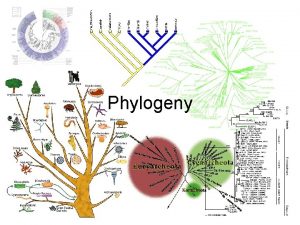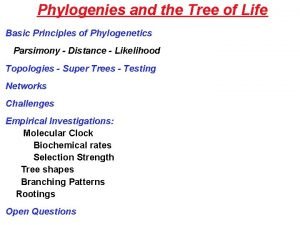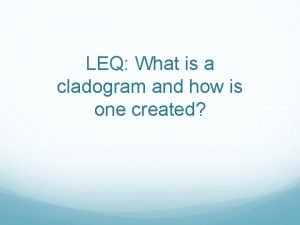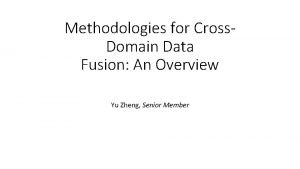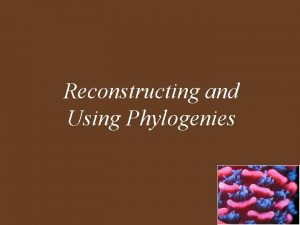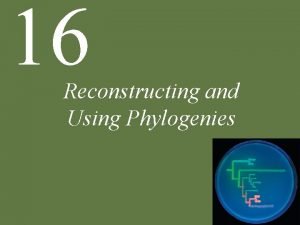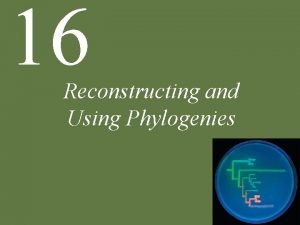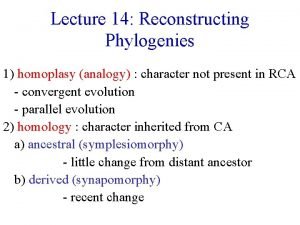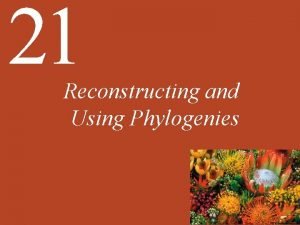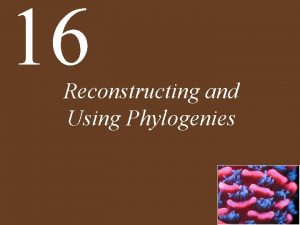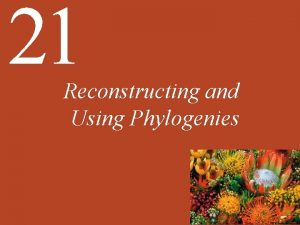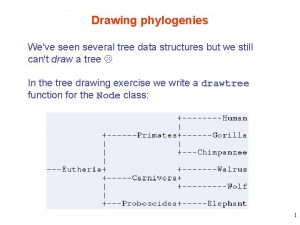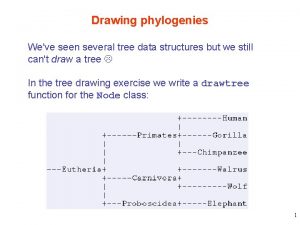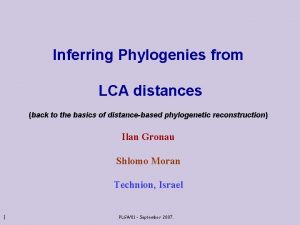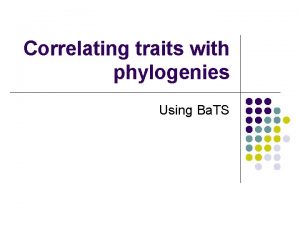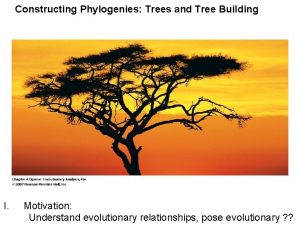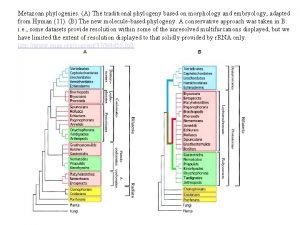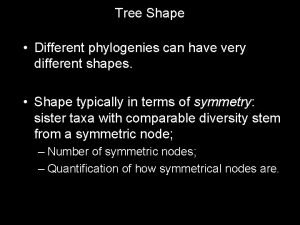Reconstructing Phylogenies from GeneOrder Data Overview What are




























- Slides: 28

Reconstructing Phylogenies from Gene-Order Data Overview

What are Phylogenies? • “Tree of Life” • A UAG representing evolution of species

Phylogenic Analysis Used For… • Phylogenies help biologists understand predict: – – – functions and interactions of genes genotype => phenotype host/parasite co-evolution origins and spread of disease drug and vaccine development origins and migrations of humans – Round. Up herbicide was developed with the help of phylogenetic analysis

Gene-Level Phylogeny • Nadeau-Taylor model of evolution – Assume discrete set of genes • Each gene represents a sequence of nucleic acids • Genes have polarity (a, -a) – A species genome is a sequence of genes – Rare evolutionary events cause changes in genome • Inversion: (a b c d) => (a –c –b d) • Transposition: (a b c d) => (a c d b) • Inverted transposition: (a b c d) => (a –d –c b) • Insertion: (a b c d) => (a e b c d) • Deletion: (a b c d) => (a c d)

Goal of Phylogenetics • Given a set of observed genomes, reconstruct an evolutionary tree – Leaves are the observed genomes – Internal nodes are evolutionary steps (“missing link” genomes) – Edges may contain multiple events • Fundamentally impossible to solve without a time machine – Fossils? • However: – Of the set of valid trees that include all observed genomes as leaf nodes, tree containing the minimum number of events (sum of edge weights) is closest to actual – “Maximum parsimony”

Tree Construction Techniques • Three primary methods: – Criterion-based (NP-HARD optimization) • Relies on an evolutionary model • Examples: – Breakpoint phylogeny – Maximum-likelihood, maximum-parsimony, minimum evolution • Provides good accuracy but intractable for larger sets of genomes – Ad hoc / distance-based • Relies on pair-wise distances • Example: – Neighbor-joining • Runs in polynomial time but very inaccurate for large sets of genomes – Meta-methods • Ex: disk-covering, quartet-based methods • Divide-and-conquer approach

Breakpoint Phylogeny Method • Sankoff-Blanchette Technique – Assume an unrooted, binary tree topology, where leaves are genomes – Basic algorithm: • For each circular ordering of genomes… • From bottom up, label each of the 2 N-2 internal nodes with a genome that has minimal distance to each of its neighbors • The tree with the minimal sum of edgeweights (height) is the most parsimonious – First problem with S-B: exponential number of genome orderings (n-1)! possible circular orderings: G 1 G 2 G 3 G 4 is equivalent to… G 2 G 3 G 4 G 1 Topology (and thus length) of tree depends solely on gene ordering

Breakpoint Distance • S-B use “breakpoint distance” to estimate distance between two genomes – Approximates number of evolutionary events – Assumes consistent gene set and sequence length – Given genomes G 1 and G 2 – If a and b are adjacent in genome G 1 but not in G 2, then bp_distance++ – Example: {a b c d} and {a c d b} have two breakpoints – Must also take polarity into account… • No breakpoint between {a b} and {-b –a} • Example: {a b c d} and {-b –a c d} – Breakpoint distance is 1

“Median Problem for Breakpoints” • S-B labels internal nodes by finding a median among 3 genomes, such that: – D(S, A) + D(S, B) + D(S, C) is minimal • Performed using a TSP: – Build fully-connected graph with an edge for each polarity of each gene – Edge weights assigned as 3 -(number of times each pair of genes are adjacent) – Run TSP – Path of salesman specifies medium

Example Median • • Assume gene set={A, B, C, D} Assume genomes: u(A, B)=0 u(A, -B)=1 u(A, C)=0 u(A, -C)=1 u(A, D)=0 u(A, -D)=0 u(-A, B)=1 u(-A, -B)=0 u(-A, C)=0 u(-A, -C)=0 u(-A, D)=0 u(-A, -D)=1 u(B, C)=0 u(B, -C)=1 u(B, D)=0 u(B, -D)=0 A B C D B D -A -C -D C B A u(-B, C)=1 u(-B, -C)=0 u(-B, D)=1 u(-B, -D)=0 u(C, D)=1 u(C, -D)=0 u(-C, D)=1 u(-C, -D)=0 2 weight=3 -(adjacencies) -1 A -A If solution to TSP is s 1, -s 1, s 2, -s 2, …, sn, -sn 2 B 2 D 2 -1 -1 2 2 -B -D 2 2 C -1 then median is s 1, s 2, …, sn -C 2 edges not shown have weight 3 (include signs)

S-B Algorithm N+2 N-2 label initialization only when nodes have changed

S-B Algorithm • S and B propose three different methods for initializing the TSPs for achieving global optimum • Second problem with S-B: – Each tree requires the solving of multiple TSPs, which themselves are NP-HARD – Initial labeling: 2 N-2 TSPs – Repeats this process an unknown number of times to optimize internal nodes

Neighbor Joining • A polynomial-time heuristic for tree construction • Given the distances between each pair of genomes (distance matrix)… • Grow a complex tree structure, starting from a star • Basic algorithm: – – – Begin with a star-topology Choose pairs of leaves that are closely related Remove these leaves and join them with a new internal node Join this new internal node somewhere into the old tree Do this until all N-3 internal nodes have been created

Neighbor-Joining N(N-2)/2 possibilities D 1 2 3 4 2 4 3 5 3 4 6 2 3 5 6 5 7 4 1 2 1 X X 3 Y 4 2 5 3 4 5 S 0=(S D)/(N-1) = 45/4 = 11. 25 S 1 2 3 2 9. 50 3 11 11. 17 4 12 10. 17 11 5 10. 83 11. 50 11. 83 4 S 3 4 10. 83 5 1 -2 3 4

Neighbor-Joining

Neighbor-Joining • Edges weight approximations can be computed with neighbor-joining • However, it is more accurate to label the internal nodes as with S-B and measure edge lengths based on this – “Scoring”

Moret’s Distance Estimators • IEBP estimator – Approximates event distance from • breakpoint distance • weights: inversion, transposition, inverted transposition – Fast but not accurate • Exact-IEBP – Returns the exact value – Slow but exact • EDE – Correction function to improve accuracy of IEBP • EDE used to build distance matrix – Set up NJ – Finding lower bound – Scoring

EDE • Distance correction • Non-negative inverse of • F(x) defines minimum inversion distance, x defines actual inversions

Bounding • Given a distance matrix, lower bound can be determined – “Tree is at least this size” – Use “twice around the tree” – Length of tree (sum of edges) is. 5 * (d 12, d 23, …, dn 1) • Given a constructed tree, upper bound can be determined – Label internal nodes – Sum up all edges using distance calculator

GRAPPA • Optimizations – Gene ordering • • Given a circular gene ordering Build a S-B tree Swap internal leaf orderings, changing the order Upper bound stays constant (no relabeling), while lower bound changes

GRAPPA • Layered search: – Build EDE distance matrix – Build and score NJ tree (provides initial upper bound) – Enumerate all genome orderings – For each: • Compute lower bound using “twice around the tree” • If LB < UB, add ordering to queue, sorted by LB – Requires too much disk space – Score each tree from queue in order: • Keep track of lowest upper bound • Allows for more pruning

GRAPPA • Without layered search: – Build EDE distance matrix – Build and score NJ tree (initial upper bound) – For each genome ordering: • Compute lower bound • If lower bound < UB • Score tree and compute new upper bound (may do swap-as-you-go to eliminate redundant orderings) • If new upper bound < old upper bound, set new upper bound

FPGA Implementation • Software can perform NJ, since that’s only done once • Software can enumerate valid genome orderings • • Scoring should be done in hardware EDE can be performed via BRAM/CLB lookup table Need to implement TSP in hardware GRAPPA uses specialized version of TSP – As opposed to chained and simple versions of Lin-Kernighan heuristic – O(n 3) • Most important question: – Map to multi-FPGA architecture?

GRAPPA Version of S-B Algorithm • Iterative refinement – Only refine internal nodes when one of the neighbors has changed in the refinement iteration • Condenasation – Gene reduction to speed up TSP for shared subsequences – Not used by default • Exact TSP algorithm • Initial labeling – Uses second approach in S-B paper (“nearest neighbors/trees of TSPs”)

Parallelism? • Scoring is very parallel – TSP only depends on three nearest nodes – Can overlap iterations • GRAPPA is parallelized for cluster – Compute, not communication bound • Achieve finer-grain parallelism with FPGAs – Problem may turn communication-bound • Research Plan – GRAPPA analysis (drill-down) – Get preliminary results for TSP over FPGA • SRC implementation (Charlie) • Determine granularity vs. communication

Possible HPRC Approach I 1 I 2 I 3 I 4 I 5 I 6 I 4 I 1 G 1 I 5 I 2 G 2 I 3 G 4 wrap-around – one TSP core buffered requests

Possible HPRC Approach input species ancesteral group 1 ancesteral group 2 g 5 g 5

HPRC • FPGAs – Comp. density • Cost – Granularity • Mesh – Load balancing
 Mikael ferm
Mikael ferm Phylogenetic tree vocabulary
Phylogenetic tree vocabulary Phylogenies
Phylogenies Inferring phylogenies using derived characters
Inferring phylogenies using derived characters Chapter 12 section 2 reconstructing society
Chapter 12 section 2 reconstructing society Chapter 12 section 2 reconstructing society
Chapter 12 section 2 reconstructing society Data quality and data cleaning an overview
Data quality and data cleaning an overview Data quality and data cleaning an overview
Data quality and data cleaning an overview Data quality and data cleaning an overview
Data quality and data cleaning an overview Master data services overview
Master data services overview Microsoft master data services
Microsoft master data services Chicago time
Chicago time An overview of data warehousing and olap technology
An overview of data warehousing and olap technology Trajectory data mining an overview
Trajectory data mining an overview Methodologies for cross-domain data fusion: an overview
Methodologies for cross-domain data fusion: an overview Www overview
Www overview Maximo overview
Maximo overview Universal modeling language
Universal modeling language Uml overview
Uml overview Vertical overview
Vertical overview Figure 12-1 provides an overview of the lymphatic vessels
Figure 12-1 provides an overview of the lymphatic vessels Pulmonary circuit
Pulmonary circuit Texas recapture districts
Texas recapture districts Walmart company profile
Walmart company profile What is stylistic overview
What is stylistic overview Overview of sa/sd methodology
Overview of sa/sd methodology Spring framework overview
Spring framework overview Nagios tactical overview
Nagios tactical overview Market overview managed file transfer solutions
Market overview managed file transfer solutions

